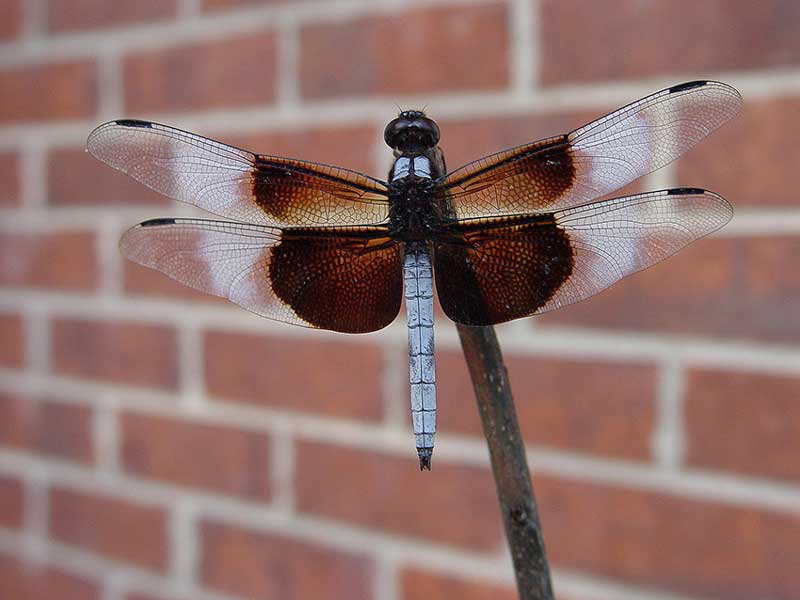RiskVA
Dragons of the Air 3 Aug 2016
It’s dragonfly season again, so at the risk of a few repetitions from a few years ago, here is my latest epistle about the insect stunt fliers that are neither dragons, nor flies, but dragonflies.
About this time of summer dragonflies begin to appear in great numbers and varieties, gracefully and effortlessly gliding around lakes and ponds. Rarely flapping their wings, they cruise the breezes around our yard and pond looking for a passing meal. Over 450 kinds of dragonflies live in North America and 5,000 to 10,000 varieties are found worldwide.
This past Friday, the afternoon of the 29th, an unusual squadron of 50 or 60 of these flying, predatory acrobats appeared in our backyard. And they were not just drifting around.
I’ve never seen so many of the same kind together. They were orange or yellow/orange, and small speed demons about one and a half inches long. Called meadowhawk dragonflies, a swarm of them zoomed around in a closely coordinated formation, diving and hovering in what looked like an aerial dogfight for twenty minutes or more.
At first, I couldn’t see any reason for their behavior. But as I walked out among them it was soon apparent that they were decimating a huge cloud of tiny gnats or midges.
Dragonflies are predators. During their short two to three weeks of life as adults, they eat mosquitoes, midges, moths, bees, butterflies, and even other dragonflies. In short, they are terrors of the skies, and their flight abilities allow them to snatch their meals right out of the air.
Independently controllable, a dragonfly’s four transparent wings enable them to do aerobatics that put modern pilots to shame. These meadowhawks certainly lived up to their reputation with continual high-speed maneuvers.
Some dragonflies can fly up to sixty miles per hour, and all of them can hover, fly backward, zoom straight up, stall, spin, sideslip, and turn on a dime. Their two huge hemispherical eyes each have about 30,000 individual facets or lenses and are especially well suited for seeing and tracking movement. And they can turn their head in all directions for target tracking.
Existing for over 300 million years, dragonflies are one of the first winged insects ever found as fossils. Present day dragonflies have wingspans of only two to six inches, but those from the geologic past had wings three feet across. Imagine a critter that size settling gently down on your head for a look around.
Dragonflies have long played an important part in myth and religion. Many stories revolve around their association with evil. Examples include the Devil’s Darning Needle in Britain, Devil’s Little Horse in Spain, and Devil’s Steelyard in Sweden. (A steelyard was an old device for weighing objects.) One tale says that the Devil uses dragonflies to weigh your soul by circling around your head. And evil things will happen to you after such a flight.
In Norway, the name means Eye Poker, and in Portugal, Eye Snatcher. Children were once warned that if they talked too much, told lies or cursed, those flying darning needles would sew their lips, eyes, and ears shut!
In the southern United States dragonflies are sometimes called Snake Doctors in the belief that they find and sew up injured snakes to help them heal. It is said whenever you see them, snakes are around. What can I say? Snakes are everywhere, so I guess that’s true.
Hopi Indians consider the dragonfly sacred. Its image is often used in healing ceremonies. And in most pueblo tribes killing a dragonfly is a serious taboo.
The Japanese Samurai called them Katsumushi – victory insect. They were sometimes painted in red, black, and gold on their helmets.
In China, dragonflies are considered good luck and are associated with riches, peace, and harmony.
As summer wanes and fall approaches, dragonfly numbers will diminish, eggs will be deposited around pond areas, and by the end of October, the adults will all have died off, to be replaced next spring by a newly-minted crop.
Dragonflies are a beautiful and beneficial part of our environment. They don’t bite or sting, and grace the outdoors with scintillating, iridescent sparkles of color. And are helpful as well. They are an important part of nature’s complex fields and forests.
Dr. Risk is a professor emeritus in the College of Forestry and Agriculture at Stephen F. Austin State University in Nacogdoches, Texas. Content © Paul H. Risk, Ph.D. All rights reserved, except where otherwise noted. Click paulrisk2@gmail.com to send questions, comments, or request permission for use.

